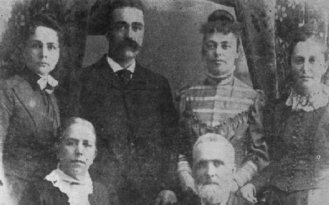Fourth Generation Farmers on Maakestad Homestead
Four generations of the Maakestad family have lived on the original land in 100 years. This is something of a record since most families have gone into the fifth and sixth generations in the same length of time.
The original settler, Johannes Peterson Maakestad (also known as John Peterson), was born in Hardanger, Norway, on March 27, 1818. He came to America in 1855 with his wife, Gjoa Olsdatter and two young children and they settled in LaSalle County, Illinois.
When they came to Mitchell county, he drove a yoke of oxen with a wagon containing their household belongings and clothes. His wife herded the three or four head of cattle. All walked the entire distance from Illinois to the homestead they claimed in Cedar township.
Johannes’ wife died in August after their arrival here, and hers was one of the first funerals in the vicinity. Of their four children, only Peder grew to manhood. He moved to North Dakota, dying there some years later a wealthy man.
In 1857, Johannes married Katherine Vambheim. Their children included Ann Marie, Gurina (Mrs. Lars Sorose) of Austin, MN; Jane Lydia (Mrs. Olaus K. Haugen) of Osage; and Martin Maakestad. Martin now owns his father’s land. Johannes died on August 9, 1876, and his second wife October 7, 1912.
Their son, Martin, who was born on March 30, 1871, has always lived on the family farm. He reads both English and Norwegian. He spends most of the summer months on the farm, living with his two sons, Edwin and John. His other children include Cora, (Mrs. Odin Sorose) of Austin, MN; Gladys, (Mrs. Clarence Klemesrud), Nora (Mrs. Kenneth Klemesrud), and Peder Leonard Maakestad, all of Osage.
Martin’s son Edwin is married to the former Helen Klemesrud. Their children include Edwin and John, who live at home; Dorothy, (Mrs. Norman Berry), California; Maurice, who lives in Cedar township; and Kenneth, who is in Waterloo. Three of their four sons have been in the service.
The first log house on the Maakestad land was a log cabin

|
Born in Norway, Johannes Peterson Maakestad came to America in 1855. He and his family came to Mitchell county by wagon and oxen, walking all the way. |
Martin Maakestad attended the old Walnut Grove school, which was two miles across country. It was further by road, and the roads were so bad, they were seldom used by the school children. Ole Jeglum was his first teacher.
Martin’s father was a charter member of the Rock Creek Lutheran church.
Martin’s father owned a 14 inch walking plow for a team of horses or oxen. He probably had no horses as they were scarce at that time. The chief crop was wheat, which was hauled to McGregor after the harvest.
John and Edwin each work half of their grandfather’s original 160 acres.
Today a systematic crop rotation plan is employed on the farm. They grow the usual crops common to this area.
